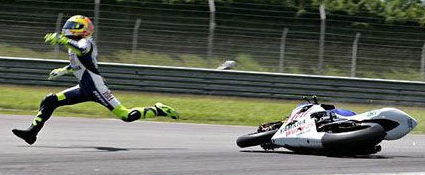I promised an overview of visual processing, so I'll throw a few things down here and my experiments with them, just for kicks.
Visual perception is not one unified perception. It is divided into 4 separate categories. Form, color, depth and motion.
Form: Essentially the shape of the object. Responsible for your ability to tell where one thing ends and another begins. At it's base, it differentiates a circle from a square.
Color: The color that you perceive object as. Pretty simple.
Depth: The distance away that you see the object as.
Motion: Your ability to tell if an object is moving or is stationary. This one is probably the most fascinating of all. Applying motion to a visualization without changing how you see it will still result in you thinking it is moving even though it doesn't move. Head hurting ensues. See below for more about this.
Now, your first instinct is probably to try and think about these in terms of what you can see. Lets say you want to think about shape so you compare a red circle to a red square in your mind's eye. But wait, WHOOPS. You have just invoked depth and color as well in order to see those shapes. You might try and say "well I'll just think of it as colorless and hanging in space at an indeterminate depth" The problem is, as soon as you see it, you DO use those attributes. You'll probably see it as white and you will see it at a particular depth away.
Each of these 4 attributes on it's own can only be conceptually described. It took me the better part of a few hours to try and be able to "feel" (theres no better word to describe it) form without seeing it. I was never able to get color by itself. Depth was fairly easy and motion was almost intuitive. By the end of all this, my head seriously hurt and I was completely out of it/I felt fairly disoriented XD.
If you want to try and pick out a single visual property yourself, try motion. You can apply it to an otherwise properly visualized object. Lets say you visualize a rectangular prism in your head. Set it rotating for a second just to get a feel for it. Now, try to rotate it again without letting the color, form or depth change. You will know when you've succeeded. You may have to go for a little walk afterward.
I did a whole lot of experiments with just combining 2 of the elements, altering 1, creating visual paradoxes (not allowing one property to change with the other) and overall just trying to define my visual space in terms of these 4 things. It doesn't seem to have helped in creating environments, though leading me to concretely believe that it is in fact a different process to create an environment then think about a single object consciously. I'm leaning towards the environment's creation is more in part due to processing and assimilation outside our direct consciousness (but probably right on the boundaries) and thus related to our thoughts about the "gut".
It also might be an explanation for why dreams are so weird. If the main contributor to dream imagery and dream logic is the space right outside our consciousness, it would make sense that it doesn't follow any determinable pattern. At any one time, the region that would be classified as right outside conscious awareness would be pretty random (but related in slight, yet abstract ways to the current awareness which is a PERFECT description of dream progression).
Thoughts?
|
|




 LinkBack URL
LinkBack URL About LinkBacks
About LinkBacks






 Reply With Quote
Reply With Quote
Bookmarks